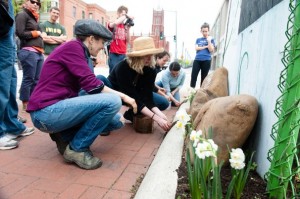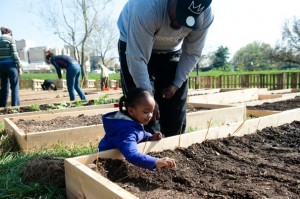 “Let’s throw some bombs,” a young woman calls out, waterproof floral purse swinging on her shoulder and Laura Ingalls braids flying behind her as a band of 25 followers cheer, “Cool!”
“Let’s throw some bombs,” a young woman calls out, waterproof floral purse swinging on her shoulder and Laura Ingalls braids flying behind her as a band of 25 followers cheer, “Cool!”
They rush toward a drab vacant lot in Shaw. Some climb up onto the back of a truck to get better aim at their target. But these bombers aren’t likely to appear on any terrorist list or even get arrested. They’re throwing “seed bombs,” golf-ball-size lumps of mud packed with wildflower seeds, clay and a little bit of compost and water, which they just learned to make at a free seed-bombing workshop for Washington’s guerrilla gardeners.
The benign bombing is part of a larger phenomenon known as activist gardening that is taking off this spring in cities such as Portland, Detroit, Baltimore and the District, where young urbanites are redefining the seemingly fusty pastime as a tool for social change. This is civil disobedience with a twist: Vegetable patches and sunflower gardens planted on decrepit medians and in derelict lots in an effort to beautify inner-city eyesores or grow healthful food in neighborhoods with limited access to fresh food.
“Guerrilla gardening is urban gardening and food justice. It’s just this really cool mix,” says Emmy Gran, 25, who is teaching seed-bombing in a floppy sun hat at a recent Saturday morning workshop in the courtyard of Old City Green, a gardening store in Shaw. “But it’s controversial, too. If you see an abandoned, neglected lot and you decide to do something about it by planting vegetables and herbs, are you an occupier? It’s kind of radical, in some ways.”
 And every radical movement needs graffiti. Gran hauls out her Cuisinart to make the green “spray-paint” required for gardening activism’s biodegradable moss graffiti. Ingredients: moss, a half teaspoon of sugar and beer or yogurt which, when blended, will stick to walls. (“You can also use buttermilk,” she adds.) With a light rain starting to fall, the group walks over to a curb near the garden store and uses the gloppy mixture to write “Nourish, Grow, Shaw” in big, moss-green letters.
And every radical movement needs graffiti. Gran hauls out her Cuisinart to make the green “spray-paint” required for gardening activism’s biodegradable moss graffiti. Ingredients: moss, a half teaspoon of sugar and beer or yogurt which, when blended, will stick to walls. (“You can also use buttermilk,” she adds.) With a light rain starting to fall, the group walks over to a curb near the garden store and uses the gloppy mixture to write “Nourish, Grow, Shaw” in big, moss-green letters.
Activist gardening is the latest face of social justice in the District. Forget living in a tent in McPherson Square. Instead, try pulling on muddy work boots and hauling fertilizer and mulch to a forlorn lot, then persuading your housemates to get off their iPads and go outdoors to plant snap peas and garlic. The group at the workshop includes former Peace Corps volunteers, environmental activists, plaid-ensconced hipsters and social justice workers, all eager to learn more about subversive or sneaky gardening, as it is also known.
“It’s all a lot less devious than it seems,” says Ellen Abramowitz, 22, who works for the Alliance to Save Energy, a nonprofit group that educates schools about energy efficiency. “Besides, who doesn’t love flowers?”
One flower at a time
Gran tells her students — most of whom were born in the 1980s — that guerrilla gardening dates from the late-1960s establishment of People’s Park in Berkeley, Calif., when a disused patch of land near the University of California campus was co-opted by the community and reimagined as a public green. Today, she says, it takes place in more than 30 countries, with much of the activity documented on the British-based website guerrillagardening.org. It has spread in the United States in recent years, spurred by the “green” movement and the increased demand for locally grown, healthful food.
by Emily Wax